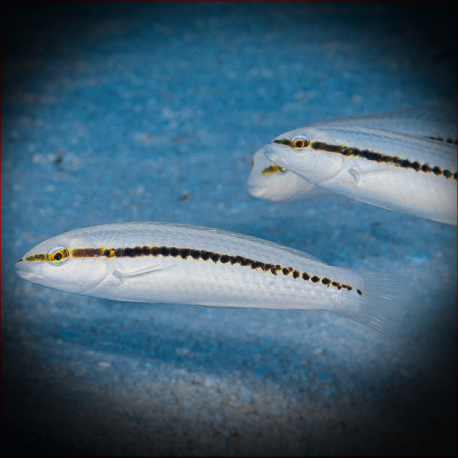More info
Datasheet
| Minimum Tank Size | 1000 litres / 264.17 US gallons |
| Maximum Size | 35.0cm / 13.78inches |
| Reef Compatible | Not reef safe |
| Temperament | Aggressive towards other species |
| Temperature | 22.2°C / 71.96°F - 25.6°C / 78.08°F |
| Specific Gravity | 1.020-1.025 |
| Carbonate Hardness | 8-12 |
| pH | 8.1-8.4 |
General Description
The Slippery Dick, scientifically known as Halichoeres bivittatus, belongs to the Labridae family and is recognized for its effectiveness in eradicating flatworms and pyramid snails in aquariums. These fish are popular due to their attractiveness and hunting skills, but they can grow quite large, making them unsuitable for smaller tanks. They exhibit various feeding behaviors, from consuming small invertebrates to crushing crustaceans, occasionally preying on creatures larger than themselves. When threatened, Slippery Dicks will bury themselves in the sand and have been noted for their ability to jump out of open aquariums.
Aquarium Suitability
Considered suitable for aquariums with caution, Slippery Dicks are known to be aggressive towards other fish species, especially smaller or docile ones. To manage their aggressive tendencies, providing regular feeding, ample hiding spots, and sufficient space is recommended. Additionally, these fish have a preference for a deep sandy substrate, requiring at least 2 inches (5 cm) to burrow in when feeling threatened or for sleeping.
Demands, Care, and Hardiness
With average hardiness, Slippery Dicks have specific care requirements, including a large tank size of at least 1000 liters when fully grown. They thrive in environments with water conditions ranging from a temperature of 22.2-25.6°C, pH of 8.1-8.4, carbonate hardness (KH) of 8-12, and specific gravity (SG) of 1.020-1.025. Their sensitivity during transportation necessitates careful acclimatization to prevent stress.
Reef Suitability
These fish are not considered reef-safe due to their aggressive behavior and tendency to rearrange rocks and corals while foraging for food. Slippery Dicks can pose a threat to small fish and are skilled hunters of invertebrates such as crustaceans, sea urchins, and worms, making them unsuitable for reef environments.
Aquarium Setup
For a Slippery Dick aquarium setup, a deep sand substrate of at least 2 inches is crucial, along with ample hiding places to mitigate aggression. Providing larger crustaceans like shrimp and crabs as part of their diet can help satisfy their predatory nature. While these fish are effective at consuming flatworms and pyramid snails, there can be variability in individual feeding preferences.
Behaviour
Slippery Dicks exhibit aggressive behavior towards other fish species and have a tendency to jump out of open aquariums. They are known to rearrange rocks and corals in their search for food and will bury themselves in the sand when threatened or seeking rest. The species also displays hermaphroditic traits, with females capable of changing sex to male when necessary.
Feeding and Diet
Recommended diets for Slippery Dicks include larger crustaceans like shrimp and crabs, as well as smaller crustaceans such as krill, mysis, and artemia. While they may consume flatworms and pyramid snails, individual preferences for these prey items can vary, and some specimens may refuse to eat them.
Dimorphism and Captive Reproduction
In terms of dimorphism, Slippery Dicks can change gender from female to male as needed. They function best as a pair, consisting of one male and one female, or with one male alongside several females. Careful consideration of gender dynamics is essential for successful captive breeding and reproduction.
Habitat and Distribution
Slippery Dicks are native to the Western Atlantic region, specifically ranging from North Carolina, USA, to Bermuda and Brazil. Their habitat includes areas with ample space for swimming and foraging for prey, contributing to their need for a large aquarium with a deep sandy substrate to mimic their natural environment.

